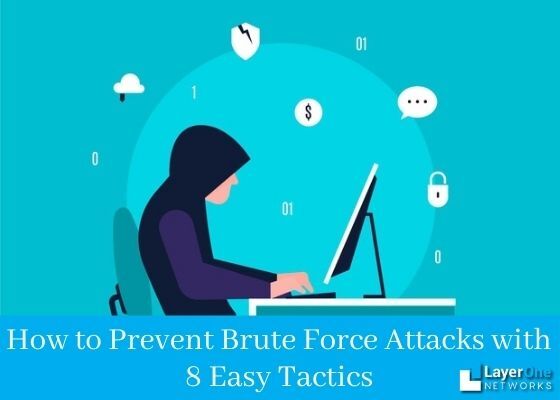Are you using an obvious, weak password?
If so, you must be wary of the brute force attack!
Unlike many other cybercrimes, brute force attacks don’t consider the vulnerability of the system. Instead, it relies on repetitively using a combination of passwords to gain access.
It’s one of the simplest ways of hacking. The basic concept of the brute force attack is that you’re bound to figure out the right password when you keep trying a combination of words, numbers, and symbols.
For example, if you are using a four-digit pin, then there are 10,000 possible combinations from 0000 to 9999. In the brute force attack, a bot will keep trying out these numerous combinations until it can log in.
In this blog, we’ll go through different ways of preventing such brute force attacks.
8 Simple Tactics to Prevent Brute Force Attacks
Ever since people started working from home due to the COVID-19 pandemic, there’s been an increase in the brute force attack of Microsoft’s proprietary protocol, RDP.
You can notice that the attacks have increased by 12x in just a month!
While you can use many antivirus, cybersecurity software to prevent many online threats, there is no such tool to avoid brute force attacks.
As one of the top companies offering security service for Corpus Christi, our IT security experts at LayerOne Networks have listed out some of the best and simple brute force attack prevention techniques to keep the hackers out.
-
1. Encourage User to Create Strong and Long Passwords
There’s a type of brute force attack called the dictionary attack that uses a list of commonly-used passwords to gain access to your account. This can speed up the time taken for finding the right password and can make users vulnerable. It’s important to encourage the users to create a password that doesn’t come under the common ones. The next important step is to have a long password.
Did you know that it takes an average of 555 hours to break a four-digit passcode?
If the hacker tries the dictionary attack and fails, the next is to go for the usual combination of characters, letters and numbers. As the password length increases, it takes a long time for the hacker to figure out the right password and can help you prevent it, if possible.
-
2. Keep the Allowed Login Attempts to a Bare Minimum
Many services are now restricting the number of login attempts to 10 or lesser. This way, the hackers wouldn’t have enough opportunity to try out multiple password combinations.
You can lock the account after a certain number of failed login attempts, which can then be unlocked after a specific time. This way, the users won’t have to go through a long process of changing the password and the hackers’ attempt will also be interrupted by locking the account from any more password combinations.
-
3. Use Captcha After a Certain Failed Login Attempts
Yes, captchas are annoying but are one of the most straightforward ways for brute force attack prevention. Captchas prevent automated bots from testing out multiple passwords since it requires manual entry. Captchas can either be audio-based or visual-based.
Sometimes, captchas can negatively impact user experience. So, you can include the captcha only after a certain number of failed login attempts to reinforce the security.
-
4. Include Security Questions
Similar to the usage of captcha after some failed login attempts, you can instead include security questions. This is an extremely effective second layer of defence if the hacker finds the password through brute force attack.
-
5. Encourage Users to Enable 2FA
Two-factor authentication (2FA) is one of the best ways to create an extra line of defence. It’s important to encourage users to enable 2FA to protect their accounts from hackers.
Usually, in 2FA, the contact number or the user’s email ID will be included to verify access after logging in with the right password. There is very little that hackers can do to gain access with 2FA.
Do you want to create a 2FA provision for your web services? Book a consultation session for security service with one of our experts at Corpus Christi.
-
6. Prevent Attacks Through SSH
SSH (Secure Shell) Protocol is one of the common protocols found in IT infrastructure. Hackers mostly use SSH to gain access to the servers by finding out the credentials using brute force.
To prevent such hacks into the server, you have to make the root inaccessible through SSH and use a non-standard port to make it harder for the hackers.
-
7. Restrict Access from New IP Addresses
To make things difficult for the hackers, you can set up an additional security layer that prevents users from logging in from IP addresses that aren’t the regular ones. Of course, you can let the user authenticate their identity if they are accessing from new IP addresses.
-
8. Regularly Monitor the Logs
You can use any tool to monitor the server logs and alert the user in case of multiple attempts to access in a short time. You can warn the user to change the password and include stronger security measures like 2FA and unique security answers to reinforce their account.
Conclusion
Since brute force attack is one of the primary hacking techniques, many hackers out there are leveraging it. Any web service provider needs to use a combination of these security techniques to prevent brute force attacks and protect the user accounts.
At LayerOne Networks, we help organizations implement robust IT security against brute force attacks and many other cybersecurity threats. We have been working with many businesses providing security service in Corpus Christi, Texas. Speak with one of our IT security experts to determine how to protect yourself and your users from such cyberattacks.

